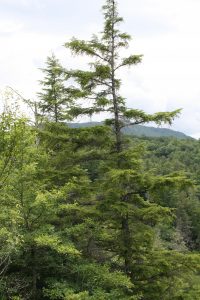Tree species face increasingly serious threats to their genetic integrity, including insect and disease infestation and climate change. At the same time, governments and their partners have limited resources to conserve and manage forest tree genetic diversity.

Carolina hemlock (Tsuga caroliniana) at Linville Gorge, North Carolina. Carolina hemlock is among the most vulnerable U.S. tree species.
To address this challenge, the USDA Forest Service has sponsored a national effort to implement a framework to prioritize forest tree species for conservation, management and monitoring in the face of multiple threats. Called Project CAPTURE (Conservation Assessment and Prioritization of Forest Trees Under Risk of Extirpation), it establishes a framework for the categorization and prioritization of forest tree species for monitoring, conservation and management actions based on identified threats to species and their life history characteristics.
The European Forest Genetic Resources Programme (EUFORGEN) now has published an article highlighting Project CAPTURE and the potential for it to serve as a basis for a similar tool for European countries struggling to choose which species to favor in their conservation and climate change adaptation plans.
“The unfortunate reality is that it’s impossible to completely conserve the genetic diversity of every species,” said Kevin Potter, a forest conservation geneticist at North Carolina State University who has coordinated the development and application of the framework. “Conservation practitioners need to apply rational, systematic, and defensible approaches to prioritize species and allocate of scarce budgets and resources.”
A paper published in 2017 describes an assessment of the vulnerability of United States tree species to climate change, using the Project CAPTURE framework. Two papers published in 2019 present a vulnerability assessment of native U.S. tree species based on a comprehensive list of the insect and disease threats, and associated severities, compiled for each of the tree species.
Read the full text of the EUFORGEN article.




